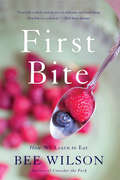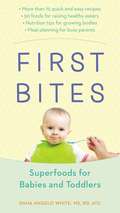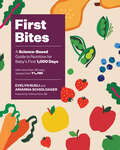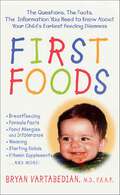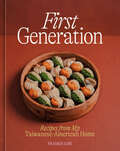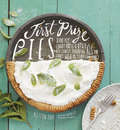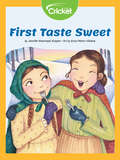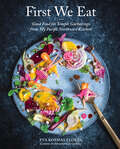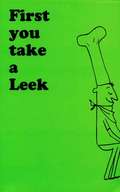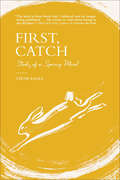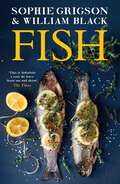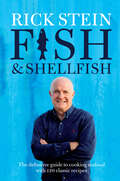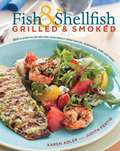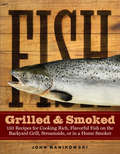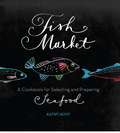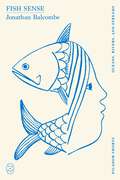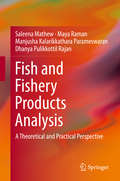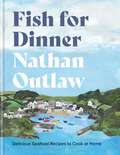- Table View
- List View
First Bite: How We Learn to Eat
by Bee WilsonWe do not come into the world with an innate sense of taste and nutrition; as omnivores, we have to learn how and what to eat, how sweet is too sweet, and what food will give us the most energy for the coming day. But how does this education happen? What are the origins of taste?In First Bite, the beloved food writer Bee Wilson draws on the latest research from food psychologists, neuroscientists, and nutritionists to reveal that our food habits are shaped by a whole host of factors: family and culture, memory and gender, hunger and love. An exploration of the extraordinary and surprising origins of our tastes and eating habits--from people who can only eat foods of a certain color to an amnesiac who can eat meal after meal without getting full--First Bite also shows us how we can change our palates to lead healthier, happier lives.
First Bites
by Dana Angelo WhiteFIRST BITES is a "cheat sheet" approach to introducing 50 superfoods into baby and toddler diets, with tips and recipes to show parents how to raise healthy eaters for life. FIRST BITES is the quick and easy reference guide that all parents can keep on hand to whip up tasty and nutritious meals for their babies and toddlers in no time. Recipes are designed to help to foster healthy eating habits and create a diet filled with 50 fresh, minimally processed superfoods that are just as delicious as they are healthy. In this book, fruit and veggies take center stage in new and exciting ways, yet parents will also learn to create healthy spins on classic kid favorites like mac and cheese, pizza, chicken fingers and cupcakes. FIRST BITES offers all the tools parents need to turn the naturally healthy foods they have on hand into delectable breakfasts, lunches, dinners and snacks designed to encourage youngsters to become strong and healthy eaters for a lifetime.From the Trade Paperback edition.
First Bites: A Science-based Guide To Nutrition For Baby?s First 1,000 Days
by Evelyn Rusli Arianna SchioldagerHelp your little one become a good, healthy eater. Until age 2, a child’s body develops at superspeed—with 60 percent of calorie intake going straight to brain development—so good nutrition is essential. Reviewed and approved by a board of pediatricians, First Bites connects nutrition and development with hard-hitting data, fascinating facts, and flavorful, healthy food. Part One examines the significance of the first 1,000 days, the most important nutrition window in life. Discover which nutrients mother and baby need when and which fundamentals to keep on hand. Learn how to start solids, avoid creating a picky eater, and spot changes in your child’s digestion. Part Two offers more than 60 easy-to-follow recipes, from pregnancy dishes for expecting mamas to basic blends for infants starting solids and tantalizing finger foods for toddlers, all free of added sugars, gluten, and dairy. Strategically introducing your wee one to 100 ingredients by age 2, the recipes proceed by baby age, meal, and total time, so you can make something tasty, quick, and simple or something good that takes a little more time. From an Apricot Turmeric Bowl and Beet Chips to Quinoa Cornbread and Zucchini Fritters, these aren’t your grandma’s recipes. They’ll help you optimize quality and time while feeding your little one and find some much-needed inner peas.
First Bites: Homemade, Nourishing Recipes from Baby Spoonfuls to Toddler Treats
by Leigh Ann ChatagnierStart your baby off right with real food to nourish their every need. First Bites teaches you the ins and outs of introducing food so good, even you will want to eat it! This adorable and innovative cookbook is packed full of easy recipes that are bursting with flavor and nutrients to expand your baby’s palette and give them the vitamins they need to thrive. Work your way through flavorful purees that will delight your baby’s taste buds and get them excited about a new world of real food. Then, you’ll transition them into eating little bites that get them ready to participate in family meal time! Your baby will not only love eating these delicious recipes but will also develop healthy eating habits early on. Recipes include: •Cinnamon vanilla pear puree •Zucchini, pea, and thyme mash up •Curry coconut sweet potatoes •Lentil and veggie fritters •Whole wheat banana mini pancakes •Peachy coconut chia pudding •White peach and raspberry smoothie •Kale and white cheddar mini frittatas •Healthy salmon fish sticks •So many more!
First Comes Marriage: The perfect slow-burn romcom you won’t be able to put down in 2024!
by Laila RafiZafar and Reshma might be husband and wife.But now it's time to fall in love...Zafar is the perfect son. After all, he does spend his head buried in the family business and sets the right example for his younger brothers. But being the perfect husband doesn't come so easily to him...Reshma didn't expect romance when she agreed to marry Zafar. And definitely not love. But there's something just about Zafar Saeed that makes her long for the romance she reads in her books, so falling for him was easy. The only issue is that he barely acknowledges her!And when Zafar and Reshma are reluctantly swept away to beautiful Mombasa for a family wedding, avoiding each other becomes even trickier. Forced to be in close proximity, Zafar and Reshma are about to discover that sometimes falling in love comes after saying 'I do'.*Heartwarming and achingly romantic, First Comes Marriage is just the slow-burn, grumpy-sunshine romance you need to read in 2023. Perfect for fans of Sara Desai, Sonali Dev and Talia Hibbert!*
First Comes Marriage: The perfect slow-burn romcom you won’t be able to put down in 2024!
by Laila RafiZafar and Reshma might be husband and wife.But now it's time to fall in love...Zafar is the perfect son. After all, he does spend his head buried in the family business and sets the right example for his younger brothers. But being the perfect husband doesn't come so easily to him...Reshma didn't expect romance when she agreed to marry Zafar. And definitely not love. But there's something just about Zafar Saeed that makes her long for the romance she reads in her books, so falling for him was easy. The only issue is that he barely acknowledges her!And when Zafar and Reshma are reluctantly swept away to beautiful Mombasa for a family wedding, avoiding each other becomes even trickier. Forced to be in close proximity, Zafar and Reshma are about to discover that sometimes falling in love comes after saying 'I do'.*Heartwarming and achingly romantic, First Comes Marriage is just the slow-burn, grumpy-sunshine romance you need to read in 2023. Perfect for fans of Sara Desai, Sonali Dev and Talia Hibbert!*
First Foods
by Bryan VartabedianParents ask pediatricians more questions about feeding than just about any other topic. So Bryan Vartabedian, M.D., a pediatrician gastroenterologist, and a father himself, has decided the time is right for a guide to feeding your child during the vital first years. In First Foods he offers authoritative, up-to-date diet guidelines for all children from newborns to preschoolers, and sound answers to essential feeding questions based on the experiences of real-life parents.
First Generation: Recipes from My Taiwanese-American Home [A Cookbook]
by Frankie GawIn this stunning exploration of identity through food, the blogger behind Little Fat Boy presents 80 recipes that are rooted in his childhood as a first-generation Taiwanese American growing up in the Midwest.&“This book will transport you, it will make you cry (again and again), and it will delight you with flavor combinations that are both new and nostalgic.&”—Molly Yeh, cookbook author and Food Network hostIn First Generation, Frankie Gaw of Little Fat Boy presents a tribute to Taiwanese home cooking. With dishes passed down from generations of family, Frankie introduces a deeply personal and essential collection of recipes inspired by his multicultural experience, melding the flavors of suburban America with the ingredients and techniques his parents grew up with. In his debut cookbook, Frankie will teach you to master bao, dumplings, scallion pancakes, and so much more through stunning visuals and intimate storytelling about discovering identity and belonging through cooking. Recipes such as Lap Cheong Corn Dogs, Honey-Mustard Glazed Taiwanese Popcorn Chicken, Stir-Fried Rice Cakes with Bolognese, Cincinnati Chili with Hand Pulled Noodles, Bao Egg and Soy Glazed Bacon Sandwich, and Lionshead Big Mac exemplify the stunning creations born out of growing up with feet in two worlds. Through step-by-step photography and detailed hand-drawn illustrations, Frankie offers readers not just the essentials but endless creative new flavor combinations for the fundamentals of Taiwanese home cooking.
First Prize Pies: Shoo-Fly, Candy Apple, and Other Deliciously Inventive Pies for Every Week of the Year (and More)
by Allison KaveA year&’s worth of seasonal, creative, and easy-to-make sweet and savory crusted treats from the award-winning owner of a renowned Brooklyn bakery and bar. When Allison Kave turned her love of pies from a hobby into a career, she unleashed a decadent array of flaky fancies unlike any the world had ever seen. From traditional dough crusts to crumb crusts, fruit fillings to cloudlike creams, Kave&’s creations are the stuff pastry dreams are made of. Now, she shares her tips, tricks, and techniques in an all-new cookbook featuring pie recipes for every week of the year. Organized by month, this book has everything from irresistibly salty snacks like her Salty Dog Cheese Pie to inventive sweets such as Root Beer Float Pie and traditional favorites like Candy Apple Pie. Kave also demonstrates how to make your pies a picturesque success with step-by-step instructions on latticing, crimping, blind baking, and more. Whether you&’re a baking beginner or an at-home pro, First Prize Pies will give you a year&’s worth of delicious inspiration.
First Taste Sweet
by Jennifer Riesmeyer ElvgrenGrace and Alice are helping their family make maple syrup! After making mistakes all day, Grace wants to prove she is responsible enough to help mix the syrup all night. Will Grace be able to help make the syrup and get to have the first taste? After all, the first taste is always the best taste!
First We Eat: Good Food for Simple Gatherings from My Pacific Northwest Kitchen
by Eva Kosmas FloresThe acclaimed cookbook author shares creative new dishes that bring Mediterranean inspiration to the seasonal ingredients of the Pacific Northwest.Eva Kosmas Flores finds inspiration in her Greek heritage and the bountiful produce of her garden in Oregon. She uses both to craft her seasonal and approachable recipes, each paired with a mouthwatering image. Showcasing her unforgettable, atmospheric photography style, First We Eat is a gorgeous reference on seasonal cooking that celebrates the beauty of the Pacific Northwest, Mediterranean influences, effortless and stylish presentations, and simple preparations, all designed to share with friends and family.
First You Take a Leek
by Virginia Carroll Maxine Jo SaltonstallIt's not exactly an onion. And it's not a chive. The leek-big, simple, and often under-appreciated and misused-is in fact an indispensable flavor component to many of the most pleasing dishes that can be cooked in a kitchen. For those of us who have stared in amazement before the odd looking, elongated green and whitevegetable in the produce department, this book offers a new understanding and appreciation for the leek. With recipes for leek and split pea soup, leeks au gratin, chicken-with-leeks casserole, among others, this entertaining cookbook intertwines recipes with humorous stories of leeks, life, and the love of food.
First You Take a Leek
by Virginia Carroll Maxine Jo SaltonstallIt's not exactly an onion. And it's not a chive. The leek-big, simple, and often under-appreciated and misused-is in fact an indispensable flavor component to many of the most pleasing dishes that can be cooked in a kitchen. For those of us who have stared in amazement before the odd looking, elongated green and whitevegetable in the produce department, this book offers a new understanding and appreciation for the leek. With recipes for leek and split pea soup, leeks au gratin, chicken-with-leeks casserole, among others, this entertaining cookbook intertwines recipes with humorous stories of leeks, life, and the love of food.
First, Catch: Study of a Spring Meal
by Thom Eagle“Eagle, a chef and food writer, uses a nine-dish lunch as the occasion to ruminate about cooking, and life” (New York Times Book Review).First, Catch is a cookbook without recipes, an invitation to journey through the digressive mind of a chef at work, and a hymn to a singular nine-dish festive spring lunch. In Eagle’s kitchen, open shelves reveal colorful jars of vegetables pickling over the course of months, and a soffritto of onions, celery, and carrots cook slowly under a watchful gaze in a skillet heavy enough to double as a murder weapon. Eagle has both the sharp eye of a food scientist as he tries to identify the seventeen unique steps of boiling water, as well as of that of a roving food historian as he ponders what the spice silphium tasted like to the Romans, who over-ate it to worldwide extinction. He is a tour guide to the world of ingredients, a culinary explorer, and thoughtful commentator on the ways immigration, technology, and fashion has changed the way we eat. He is also a food philosopher, asking the question: at what stage does cooking begin? Is it when we begin to apply heat or acid to ingredients? Is it when we gather and arrange what we will cook—and perhaps start to salivate? Or does it start even earlier, in the wandering late-morning thought, “What should I eat for lunch?”Irreverent and charming, yet also illuminating and brilliantly researched, First, Catch encourages us to slow down and focus on what it means to cook. With this astonishing and beautiful book, Thom Eagle joins the ranks of great food writers like M.F.K. Fisher, Alice Waters, and Samin Nosrat in offering us inspiration to savor, both in and out of the kitchen.Winner of the Fortnum and Mason’s Debut Food Book AwardShortlisted for the 2018 Andre Simon Food & Drink Book of the YearBBC Radio 4 Food Programme Best Foodbooks of 2018Times Best Food Books of 2018Financial Times Summer Food Books of 2018“A contemplation of cooking and eating, a return to the great tradition of food writing inspired by M.F.K. Fisher’s The Gastronomical Me . . . Eagle writes with a wit and sharpness that can turn a chapter on fermenting pickles into a riff on death and decay while still making it seem like something you would like to put in your mouth.” —Mark Haskell Smith, Los Angeles Times“In two dozen short chapters linked like little sausages, he serves up a bounty of fresh, often tart opinions about food and cooking . . . Eagle is a natural teacher; his enthusiasm and broad view of food preparation is both instructive and inspiring . . . Eagle’s prose, while conversational in tone, is as crafted and layered as his cuisine. Never bland, it is also brightly seasoned with strong opinions . . . Rare among food writing, this book is bound to change the way you think about your next meal.” —Heller McAlpin, Christian Science Monitor
Fish
by William Black Sophie Grigson'Initially I was surprised by just how little time it takes to cook fish. Sometimes seconds will do, and you seldom need to spend more than a few minutes when cooking a fillet of fish. Yes, precision is vital to avoid overcooking, but quite honestly there is no great mystery to it.'Originally published in 1998 and shortlisted for the Best Food Book in the 1999 Glenfiddich Food and Drink Awards, FISH has now been fully updated by Sophie Grigson.In FISH, Sophie creates accessible modern-day recipes for both the novice and the experienced cook. From Halibut with Welsh Rarebit Crust and Maryland Crabcakes, to Greek Octopus and Red Wine Stew and Lobster Thermidor, there are recipes for all tastes - plus helpful tips on buying, storing and preparing fish from William Black.This is the only book you will ever need on fish and fish cookery.
Fish
by William Black Sophie Grigson'Initially I was surprised by just how little time it takes to cook fish. Sometimes seconds will do, and you seldom need to spend more than a few minutes when cooking a fillet of fish. Yes, precision is vital to avoid overcooking, but quite honestly there is no great mystery to it.'Originally published in 1998 and shortlisted for the Best Food Book in the 1999 Glenfiddich Food and Drink Awards, FISH has now been fully updated by Sophie Grigson.In FISH, Sophie creates accessible modern-day recipes for both the novice and the experienced cook. From Halibut with Welsh Rarebit Crust and Maryland Crabcakes, to Greek Octopus and Red Wine Stew and Lobster Thermidor, there are recipes for all tastes - plus helpful tips on buying, storing and preparing fish from William Black.This is the only book you will ever need on fish and fish cookery.
Fish
by Tom AikensWe are constantly being told about the benefits of eating fish and seafood - high in protein, low in fat and rich in nutrients. Yet we also know that species like cod and tuna are in danger of extinction while unscrupulous trawlers are over-fishing waters around the world. In this stunning new collection of fish recipes, Tom Aikens takes readers with him on a voyage of discovery. Having travelled to fish markets and spoken to fishermen worldwide, his recipes include new takes on ever-popular fish, such as sea bass, scallops and oysters, as well as ideas for lesser known but underfished, species like megrim sole, ling and gurnard. While urging us to ensure that we eat only sustainably sourced, line and net-caught fish, Aikens organises the book by cooking method - frying, baking, poaching, grilling, marinating and steaming. Each chapter has a dazzling array of mouthwatering dishes - whole bream baked in sea salt and fennel seeds; deep fried squid with lime and Aioli; grilled sardines with thyme and garlic; scallops with pan-fried pork belly; crab salad with lemon and orange; barbecued mullet with dill. Beautifully illustrated with specially commissioned photography, including step-by-step photographs for techniques such as descaling and filleting, this is a mouthwatering cookbook written by a chef who is passionate about his work. It is destined to become an essential addition to any cook's kitchen.
Fish & Shellfish
by Rick SteinRick Stein’s lifelong passion for cooking fish and shellfish has formed the foundation of his award-winning restaurants and taken him around the world, discovering innovative new recipes, exciting ingredients and the best preparation techniques. In this completely revised, updated and re-designed edition – including brand new recipes – of his classic Seafood, Rick offers comprehensive and inspirational how-to's for choosing, cooking and enjoying fish, shellfish and more. It includes a step-by-step guide to over 60 essential techniques to prepare all types of seafood: from poaching and salting fish to cleaning mussels and cooking lobster. Based on the methods taught at his Padstow seafood school, every step of Rick’s advice is illustrated with full-colour photographs for perfect results. Over 120 recipes from across the world include light salads, delicious starters and spectacular main courses – from Monkfish Vindaloo and Rick's own version of Salt and Pepper Squid to deliciously simple classics like Grilled Sardines and Clams with Garlic and Nut Picada. Complete with tips on buying, storing and sourcing sustainable fish, Rick Stein’s Fish and Shellfish is the essential companion for any fish-lover’s kitchen.
Fish & Shellfish, Grilled & Smoked
by Karen Adler Judith M. Fertig300 foolproof recipes for everything from Amberjack to Whitefish, plus really good rubs, marvelous marinades, sassy sauces, and sumptuous sides.
Fish Grilled & Smoked: 150 Recipes for Cooking Rich, Flavorful Fish on the Backyard Grill, Streamside, or in a Home Smoker (Lyons Press Series)
by John ManikowskiLearn the best recipe for walleye, the subtlest way to smoke tuna, and a foolproof method for grilling bluefish. Master chef and fisherman John Manikowski presents 150 flavorful recipes for grilling and smoking freshwater and saltwater fish. In addition to tickling your taste buds, Manikowski provides step-by-step instructions for building a smoker of your own — on the grill, a backyard fire pit, or even in the wild. Wrap that smallmouth bass in cornhusks, soak that yellow perch in grapefruit marinade, and bring your appetite.
Fish Market: A Cookbook for Selecting and Preparing Seafood
by Kathy HuntEverything you need to know about selecting, cleaning, preparing, and cooking healthful fish and shellfish.
Fish Oil: How this natural healer can help arthritis, skin disorders and encourage better health (Wellbeing Quick Guides)
by Liz EarleLiz Earle looks at the latest research into Britain's most popular health supplement and explains how it can be used to relieve a variety of ailments, including arthritis, psoriasis and eczema.Bestselling beauty and wellbeing writer Liz Earle's fully revised and updated quick guide to cod liver oil, including:- The history of the oil and its legendary properties- How essential fatty acids work- The latest research into the oil for arthritis - How it helps the skin (including eczema and psoriasis problems)- A dosage guide for the family
Fish Sense (Picador Shorts)
by Jonathan BalcombeA quirky, intimate, and eye-opening look into the ways of thinking like a fish.An extract from the much-loved modern classic on the subject of fish consciousness, What a Fish Knows.Do fishes think? Do they really have three-second memories? And can they recognize the humans who peer back at them from above the surface of the water? Jonathan Balcombe dives in among our marine cousins to explore the essential questions of how fish perceive and process the world.With his ethologist’s gift for showing us the hidden depths of questions we’ve routinely preferred to think of as simple, and his raconteur’s flair for the surprising and the curious, Balcombe takes us under the sea, through streams and estuaries, and to the other side of the aquarium glass to reveal the surprising capabilities of fishes. Balcombe upends our assumptions about fishes, portraying them not as unfeeling, dead-eyed feeding machines but as sentient, aware, social, and even Machiavellian―in other words, much like us.Using humor and a repertoire of some of the most surprising fish facts you’ve ever heard, Balcombe shakes up what you think you know about what’s going on inside the mind of these denizens of the deep.Fish Sense is part of the Picador Shorts series “Oceans, Rivers, and Streams” in which excerpts from beloved classics speak to our relationship with our water bodies, great and small.
Fish and Fishery Products Analysis: A Theoretical and Practical Perspective
by Maya Raman Saleena Mathew Manjusha Kalarikkathara Parameswaran Dhanya Pulikkottil RajanThis novel and informative book discusses the various aspects of seafood quality. The book is divided into 7 broad sections, each tackling a different aspect. The first section covers the general aspects relevant to the nutritional quality of the fish and the various extraction protocols for macro-/ micro-nutrients. The second section provides insights into handling and the principles of thermal and non-thermal processing techniques for commercially important fishery products. The quality standards and safety concerns in the seafood industry and consumption are discussed in this section. The freshness indices of the processed products including biochemical, microbiological and toxicological characteristics are also included. The third section discusses the physico-chemical characteristics and quality parameters of potable water/ ice. The fourth section includes the quality assessment of various toxicants related to seafood products. The fifth section deals with the specific aspects such as principle, instrument and procedures of conventional and novel analytical instruments relevant to the seafood industry. The sixth section deals with the seafood waste management including solid and liquid seafood wastes. Presently, there is a great awareness regarding environmental sustainable processing/ preservation techniques. The final chapter discusses the bioactive compounds from under-utilized marine sources showing pharmaceutical/ nutraceutical applications.
Fish for Dinner: Delicious Seafood Recipes to Cook at Home
by Nathan Outlaw'Simply delicious recipes by the master of fish.' Jamie Oliver'No one cooks fish like Nathan, one of the most talented chefs in the UK. This book brings all his talent to the home cook.' Angela HartnettA BRAND NEW collection from the UK's most celebrated fish chef that explains what fish to cook and how to cook it, and provides tasty and inspiring ways to cook seasonal and sustainable fish for dinner.In Fish for Dinner, Michelin-starred seafood chef Nathan Outlaw gives his expert advice on what fish to cook and how to cook it, alongside more than 70 of his best seafood recipes. With illustrated preparation techniques, all of Nathan's top tips and species substitutes for every recipe, it is easy to cook delicious fish at home. From hearty stews to delicate soups, moreish snacks to perfect pan-fried dinners and super seafood salads to smoky barbecue specials, there is a fish dish for every occasion.
